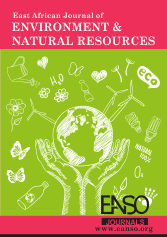Perception of Local Communities Towards Conservation of Traditional Medicinal Plants in Karongi District, Rwanda
Abstract
Traditional medicinal plants played an important role in Rwanda’s health, environmental, and cultural systems. This study assessed the perception of local communities towards the conservation of traditional medicinal plants in the Karongi District, specifically in the Bwishyura and Ruganda Sectors. Using a cross-sectional descriptive method, data were collected (analyzed with SPSS) from 398 participants through structured questionnaires, but field observations were also used. The study identified over 130 species of traditional medicinal plants, where Tetradenia riparia is the most commonly used by 86.68% of respondents. A significant majority (85.93%) were aware of Traditional medicinal plants, and 45.48% reported that they frequently use them. Additionally, 55.78% of participants strongly agreed that traditional medicinal plants are important in Rwanda’s healthcare system. The most common uses of traditional medicinal plants were for treating digestive problems (66.83%) and skin diseases (61.56%). Most respondents (74.62%) reported that they obtain them from natural vegetation such as forests and wetlands, while 51.76% attain them from home gardens. However, 82.66% of participants think that access to traditional medicinal plants has decreased. The main reasons cited were urbanization (68.34%), agricultural expansion (58.04%), and deforestation (46.26%). Participants show that the most preferred conservation practices are allowing plants to regenerate (55.78%), and replanting after harvesting (49.25%). 21.61% reported the absence of specific conservation measures. Key challenges identified were a lack of knowledge of conservation methods (74.62%) and knowledge of traditional medicinal plants (69.10%), followed by government restrictions and limited access to land. The study concludes that enhancing community awareness through workshops and promoting intergenerational knowledge transfer can strengthen the conservation and sustainable use of traditional medicinal plants in Rwanda.
Downloads
References
Dike, E. O. (2015). Ethnobotanical survey for potential anti-malarial plants in South-Western Nigeria. Journal of Ethnopharmacology, 173, 287–298. https://doi.org/10.1016/j.jep.2015.06.042
Elias, A., & Fabien, F. (2024). This refers to a study on Urtica massaica as antibiotic in Rwanda.
Eshete, M. A., & Molla, E. L. (2021). Cultural significance of medicinal plants in healing human ailments among Guji semi pastoralist people, Suro Barguda District, Southern Ethiopia. Journal of Ethnobiology and Ethnomedicine, 17(1), 1–18. https://doi.org/10.1186/s13002-021-00487-4
Hamilton, A. C. (2004). Medicinal plants, conservation, and livelihoods. Biodiversity & Conservation, 13(8), 1477–1517.
IUCN. (2022). The IUCN programme on conservation 2021–2024. https://www.iucn.org
Kabanda, J., Habimana, J., & Himbaza, J. (2020). The impact of agricultural development on biodiversity in Rwanda: A case study of the Bwishyura sector. Journal of Environmental Conservation, 15(3), 123–136.
Kala, C. P. (2005). Current status of medicinal plants used by traditional Vaidyas in Uttaranchal state of India. Ethnobotany Research and Applications, 3, 267–278.
Levin, K. A. (2006). Study design III: Cross-sectional studies. Evidence-Based Dentistry, 7(1), 24– 25. https://doi.org/10.1038/sj.ebd.6400375.
McPhee, D. J. (2016, April). The traditional medicine and modern medicine from natural products. The Traditional Medicine and Modern Medicine from Natural Products.
MINALOC. (2020). Karongi District Development Plan 2020–2026. Ministry of Local Government, Rwanda.
Ministry of Health, Rwanda. (2019, February). National Policy of Traditional, Complementary and Alternative Medicine. Government of Rwanda.
Munyabwari, S., Gatare, J., & Ntakirutimana, G. (2017). A role of traditional medicine in the health sector of Rwanda. African Journal of Traditional, Complementary and Alternative Medicines, 14(4), 214–223.
Ndamwizeye, A., Kaboneka, S., & Ntezimana, D. (2020). The conservation and utilization of medicinal flora in Rwanda: An examination of indigenous knowledge systems. Ecological Research, 19(5), 1017–1032.
NISR. (2022). National Institute of Statistics of Rwanda. https://www.statistics.gov.rw
Nkubito, A., Rugege, S., & Ndimubandi, A. (2019). The sustainable management and preservation of medicinal flora in Rwanda: Obstacles and prospects. International Journal of Biodiversity, 11(2), 45–59.
Nsengimana, H., Habiyaremye, G., & Nduwayezu, A. (2021). Traditional medicinal plant use and conservation in Rwanda. African Journal of Environmental Science.
Oladele, A. T., Alade, G. O., & Omobuwajo, O. R. (2011). Medicinal plants conservation and cultivation by traditional medicine practitioners in Aiyedaade Local Government Area of Osun State, Nigeria. African Journal of Natural Medicines, 2(3), 476–487.
RDB. (2020). Tourism and conservation strategy for Rwanda. Rwanda Development Board.
REMA. (2015). State of environment and outlook report: Biodiversity conservation in Rwanda. REMA.
REMA. (2019). State of environment report for Rwanda. Rwanda Environment Management Authority.
Rwanda Meteorology Agency. (2021). Annual climate report. https://www.meteorwanda.gov.rw
Tan, M., Otake, Y., Tamming, T., Akuredusenge, V., Uwinama, B., & Hagenimana, F. (2021). Local experience of using traditional medicine in northern Rwanda: A qualitative study. BMC Complementary Medicine and Therapies, 21, 123.
Tesfaye, Y., & Awas, T. (2018). Ethnobotanical study of traditional medicinal plants used to treat human ailments in West Shoa Zone, Oromia Region, Ethiopia. BMC Complementary Medicine and Therapies, 18, Article 92. https://doi.org/10.1186/s12906-018-2160-6
Welz, A. N., Emberger Klein, A., & Menrad, K. (2018). What motivates new, established and long term users of herbal medicine? Is there more than “push” and “pull”? BMC Complementary and Alternative Medicine, 18(92). https://doi.org/10.1186/s12906-018-2160-6
World Health Organization (WHO). (2000). General guidelines for methodologies on research and evaluation of traditional medicine. WHO.
World Health Organization (WHO). (2013). Traditional medicine strategy: 2014–2023. WHO.
World Health Organization (WHO). (2019). Traditional and complementary medicine. https://www.who.int/traditional-complementary-integrative-medicine
World Health Organization. (2002). World report on violence and health. World Health Organization. https://www.who.int/publications/i/item/9241545615
Copyright (c) 2025 Celestin Nkusi

This work is licensed under a Creative Commons Attribution 4.0 International License.




























